
Australiceras is an extinct ammonite genus from the upper part of the Early Cretaceous, Aptian stage, included in the family Ancyloceratidae.
Kamerunoceras is an extinct cephalopod genus belonging to the ammonite family Acanthoceratidae, found in Upper Cretaceous formations of Africa, Europe and North and South America.
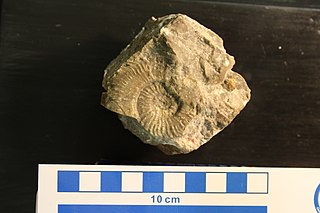
Arpadites is a genus of ceratitids in the family Trachyceratidae from the Middle and Upper Triassic of Nevada, Alps, Italy, Balkans, Himalayas, and Japan.

Acanthoceratidae is an extinct family of acanthoceratoid cephalopods in the order Ammonitida, known from the Upper Cretaceous. The type genus is Acanthoceras.
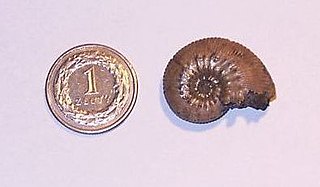
Kosmoceras is a moderately evolute ammonite genus from the upper Callovian of Europe with a simple apterure and irregular ribbing interrupted by an irregular row of lateral tubercles. Strong ventral tubercles are separated by a smooth depression running along the rim.
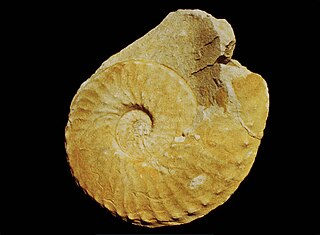
Schloenbachia is a genus of ammonoid cephalopods from the Cenomanian stage of the Upper Cretaceous, and type for the Schloenbachiidae, a family within the ammonitid Hoplitoidea.

Peltoceras is an extinct ammonite genus from the aspidoceratid subfamily Peltoceratinae that lived during the later part of the Middle Jurassic.
Subcollina is a genus of evolute to serpenticonic stephanoceratacean ammonites from the Middle Jurassic (Baj) of Mexico, placed in the family Spiroceratidae.
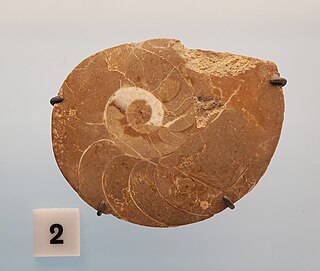
Mimagoniatites is a genus of ammonoid cephalopod which lived during the early Devonian, regarded as belonging to the Agoniatitdae as a member of the subfamily Mimagoniatitinae.

Collignociceras is a strongly ribbed and tuberculate, evolute ammonite from the Turonian of the western U.S. and Europe belonging to the ammonitid family Collignoniceratidae. The genus is named after the French paleontologist Maurice Collignon. The type is Collignoniceras woollgari, named by Mantell in 1822 for specimens from Sussex, England.
Californites is a genus of the Upper Triassic clydonicoidean family Clionitidae with a discoidal, evolute shell and radial tuberculate ribs that end in strong ventrolateral spines. The whorl section is described as trapezoidal. The venter is low-arched, smooth, and has a strong but narrow median groove.

Forresteria is an extinct genus of cephalopod belonging to the subclass Ammonoidea. They flourished during the late Turonian and early Coniacian of the Late Cretaceous, and were global in extent. Forresteria alluaudi and Forresteria hobsoni are considered marker fossils for the lower Coniacian in the American West.

Menuites is a genus of extinct ammonites, forming a rather small offshoot of Anapachydiscus with a fairly widespread distribution from the Upper Cretaceous Santonian and Campanian stages.
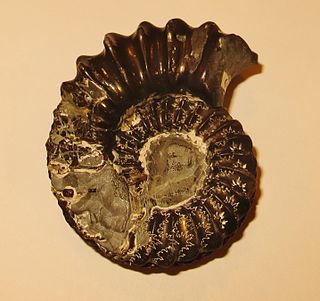
Hecticoceras is an ammonite genus belonging to the haploceratoid family Oppeliidae, that lived during the Middle and Late Jurassic, from the Callovian. Hecticoceras may be seen as a series of some nine subgenera, beginning with the lower Callovian H. (Hecticoceras) and H. (Hecticoceratoides) and ending with the lower Oxfordian H. (Pseudobrightia) and H. (Eochetoceras). Hecticocerassensu lato and Prohecticoceras from the underlying Bathonian form the oppeliid subfamily, Hecticoceratinae.
Shloenbachiidae is a family of hoplitoid ammonoid cephalopds mostly from the lower Upper Cretaceous,.

Hemihoplites is an extinct genus of ammonoid cephalopods belonging to the family Hemihoplitidae. These fast-moving nektonic carnivores lived in the Cretaceous period, from Hauterivian age to Barremian age.

Mammitinae comprises a subfamily within the Acanthoceratidae (Ammonoidea) characterized by moderately to very evolute shells with rectangular to squarish whorl sections along with blunt umbilical and prominent inner and outer ventrolateral tubercles on sparse ribs that may be round and strong, sharp and narrow, or absent. The suture is somewhat simpler than that of the Acanthoceratinae. Range is restricted to the lower Turonian stage of the Upper Cretaceous.
Cunningtoniceras is a stocky acanthoceratid ammonite from the upper Cenomanian stage of the late Cretaceous of the western U.S., found e.g. in Arizona and New Mexico.
Neocardioceras is a genus of evolute acanthoceratid ammonites from the uppermost Cenomanian, Upper Cretaceous, of Europe, western U.S. and Brazil.
Romaniceras is a genus of Upper Cretaceous ammonites in the Acanthoceratidae subfamily Euomphaloceratinae.












